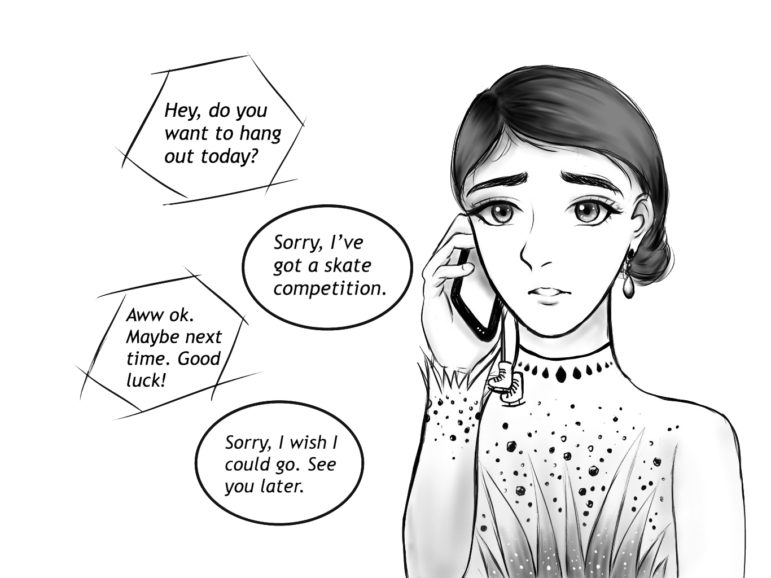It’s 4 a.m. and most people are still asleep. A lone car softly rumbles down the road, heading to an ice rink. Outside, the sun has barely risen, but in the rink, a young girl laces her skates with practiced hands. Alone, the skater steps onto the smooth ice, where she will carefully carve lines and turns for the next two hours.
This early morning routine is only a fraction of a figure skater’s daily grind.

“On weekdays, I wake up at 4 or 5 a.m. and skate for about two hours, but on weekends, it’s closer to three,” said freshman Ariana Tao. “I have to give up my sleep and have less time for TV and computer games, but I don’t care because skating is more important to me.”
Not only do competitive skaters wake up early to practice, but they also need to train daily to stay in shape. With a few inches or pounds extra, a skater’s ability to do gravity-defying jumps and tricks on the ice changes drastically. In order to stay consistent, skaters exercise vigorously off-rink, even during the off-season.
“I took ballet and jazz dance outside of Aragon and my coach would recommend off-ice training on Saturdays at a gym,” said senior Shweta Ashokraj, a former figure skater. “I would also train off season for track.”
However, given the importance of skaters maintaining a certain weight, anorexia and other eating disorders are risks in the sport. Many famous figure skaters, such as Gracie Gold, Suzuki Akiko and Yulia Lipnitskaya, have suffered from eating disorders. Lipnitskaya, encouraged by her coach, would sometimes diet on only powdered nutrients. The pressure of competition or pressure from coaches can push skaters toward unhealthy lifestyles.
“There is a lot of pressure from seeing other skaters because those who do well have a certain body type,” Tao said. “It’s not bad unless you take it too far, but maintaining a good figure is definitely part of the sport.”
Skating also requires a significant financial commitment.
“I was paying $1,000 [for skates], going through them in five to six months, on top of $60 per lesson with five lessons per week and [also] for competitions and traveling,” Ashokraj said. “It was draining money that [my parents and I] wanted to put for college.”
Despite the large commitment associated with figure skating, many skaters fall in love with the culture and the payout that the sport allows. Freshman Raven Myles commits to skating to uphold her long-standing family tradition.
“[During] competitions, I have to miss social events and going out with my friends,” Myles said. “[But] I love ice skating and also keep doing it because I want to keep [my] family tradition going on … all my siblings have done [figure skating] and we plan to have our future kids do [it]. We all bond over [skating]. [During] the Winter Olympics, we all get together and watch it as a family because it’s something we can all enjoy and understand.”
The hard work and commitment can bring impressive results, accomplishments and self-fulfillment.
“I did really well in a competition in Asia that was televised, so it was super exciting,” Tao said. “I did make a mistake, but I was pretty proud of myself at that time.”
While she was skating, Ashokraj also took pride in competing against high-level skaters around the world.
“[I] competed [at Worlds] in San Jose, and it was really nice placing in that competition,” Ashokraj said, “because [there were] people from all over the world [and I was] competing with some of the best ice skaters.”
Figure skaters also learn hard and true life lessons from their sport. Skating is not just a physical sport, but a mental one as well. The sport teaches skaters drive and organization.
“[Skaters] don’t have any room for free time, so they have to be organized,” Ashokraj said. “It helps a lot with school — managing time, figuring out what to do when, and staying organized and responsible.”
Despite the huge time and financial commitments, more and more skaters pursue the sport at a young age. With the rise of stars like Yuzuru Hanyu, Nathan Chen and Mirai Nagasu in the PyeongChang Winter Olympics, figure skating has become increasingly popular among young people.




